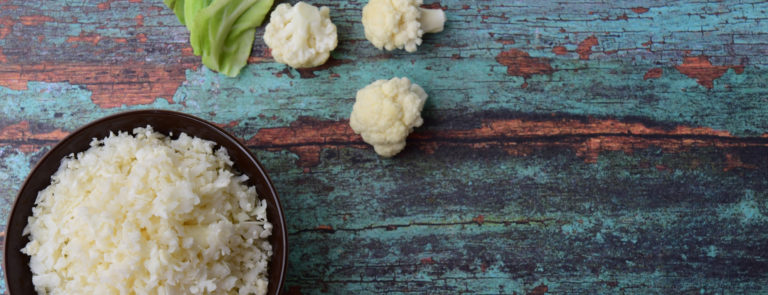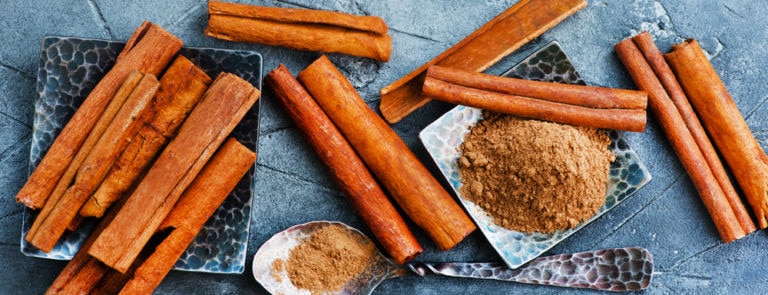10% off £35
12 healthy alternatives to rice

Cheap, filling, and oh-so-delicious when mixed with something flavourful, it’s little wonder why rice is a diet staple.
But it’s jam-packed full of carbs, high in calories, and can make you feel bloated if you eat too much of it, so rice might not be suitable for everyone.
Here, we explore some of the healthiest (and tastiest!) alternatives to rice, so you can swap it out with ease.
In this article, we’ll run through:
- What rice is and why it can be bad for us
- 12 rice alternatives and why to opt for them
- Low carb and keto rice alternatives
- Rice substitute examples for popular rice dishes
What is rice?
Most of us have had rice at some point in our lives, but what actually is it? Rice is an edible cereal grain produced by the grass plant Poaceae.1
Approximately half of the world’s population relies on rice as a staple food in their diet.
Why is rice bad for us?
But rice is best for us as a small part of a healthy balanced diet. Want to find out more? Here are a few reasons why rice (especially white rice) can be bad if you eat it a lot:
- It could increase your risk of diabetes. White rice especially has a high glycaemic index, which means its carbs are turned into blood sugar more rapidly than brown rice.2
- It may increase your risk of metabolic syndrome, a group of risk factors that could increase the risk of health conditions like heart disease and high blood pressure. Studies show that people who regularly eat large amounts of white rice have a higher risk of metabolic syndrome.3,4,5
Reasons to opt for rice alternatives
We’ve covered why rice can be bad for you, but why not stick to it in small portions?
This may be hard to do if you’re used to having rice in multiple meals a week. So to help shake things up a bit, you can swap it out for a rice alternative.
Another reason to opt for rice alternatives is if you’re trying to stick to a calorie deficit as rice can be pretty high in calories if you’re used to big portions.
12 healthy rice alternatives
So what kinds of foods can you have as substitutes to rice? From riced vegetables to other kinds of grains, thankfully there are a range of healthy rice alternatives you can try. Try swapping it out for some of these simple substitutes:
-
Riced cauliflower
A great low-carb alternative to rice, is riced cauliflower. It’s a great alternative to rice as it has a very similar consistency and texture, but with a fraction of the calories and carbohydrates.
Take a ½ cup of riced cauliflower and you’ll find it only has 13 calories, whereas the same serving of white rice has 100 calories.6
100g of riced cauliflower contains the following nutrients:7
| Energy | 25kcal |
|---|---|
| Total fat | 0.3g |
| Sodium | 30mg |
| Potassium | 299mg |
| Carbohydrates | 5g |
| Fibre | 2g |
| Protein | 1.9g |
Great paired with: Curries
-
Riced broccoli
Similar to riced cauliflower, riced broccoli is a great alternative to white rice.
Aside from having a similar amount of calories to riced cauliflower (57 grams per ½ cup), riced broccoli is also a good source of vitamin C, providing over a quarter of your daily value.8,9
Here are just some of the many benefits of vitamin C:10
- Acts as an antioxidant
- Supports immunity as it helps it to mount and sustain an adequate response against pathogens, without damaging the host11
- Helps with iron absorption
100g of riced broccoli contains the following:12
| Energy | 24kcal |
|---|---|
| Total fat | n/a |
| Sodium | 24mg |
| Potassium | n/a |
| Carbohydrates | 4.8g |
| Fibre | 3.6g |
| Protein | 2.4g |
Great paired with: Poke bowls
-
Barley
With its chewy texture and earthy taste, barley is a delicious, healthier alternative to rice.
It’s about the same in calories as white rice, but it does contain more protein and fibre. It also contains a range of nutrients, including zinc and selenium.13
100g of barley contains the following:14
| Energy | 125kcal |
|---|---|
| Total fat | 0.4g |
| Sodium | 3.1mg |
| Potassium | 94.9mg |
| Carbohydrates | 28.6g |
| Fibre | 3.9g |
| Protein | 2.3g |
-
Chopped cabbage
The low carb content and mild flavour of chopped cabbage makes it a great alternative to rice.
It’s a good source of vitamins C and K (which helps regulate blood clotting and circulation, as well as contributing to bone health).15
100g of chopped cabbage contains the following:16
| Energy | 22kcal |
|---|---|
| Total fat | 0.1g |
| Sodium | 7.9mg |
| Potassium | 194mg |
| Carbohydrates | 5.4g |
| Fibre | 1.8g |
| Protein | 1.3g |
Great paired with: Paella
-
Quinoa
Quinoa is a popular rice substitute that has a grain-like taste.
It’s gluten-free and has a high protein content – just ½ cup of quinoa contains four grams of protein, which is double the amount found in the same serving of white rice.17
So it’s a great sauce of protein for vegetarians or vegans.
It’s also a complete protein, which means it contains all nine of the vital amino acids needed by your body.18
For more nutritious alternatives to rice, check out our selection of pastas, pulses, and grains.
100g of quinoa contains the following:19
| Energy | 119kcal |
|---|---|
| Total fat | 1.9g |
| Sodium | 7mg |
| Potassium | 171.7mg |
| Carbohydrates | 21.6g |
| Fibre | 2.8g |
| Protein | 4.4g |
Great paired with: Fried 'rice' recipes
-
Wholewheat couscous
Another popular but healthy alternative to rice is wholewheat couscous.
As well as being similar in texture to white rice, couscous is also a great source of protein for people on a plant-based or vegan diet.
100g of wholewheat couscous contains the following:20
| Energy | 114kcal |
|---|---|
| Total fat | 0.2g |
| Sodium | 5.1mg |
| Potassium | 5.1mg |
| Carbohydrates | 23.4g |
| Fibre | 1.4g |
| Protein | 3.9g |
Great paired with: Spiced roasted vegetables
-
Shirataki konjac rice
Hailed as ‘miracle’ rice or noodles, shirataki konjac products are a rare type of food that’s low in calories yet filling.
This is due to the fact that it’s high in glucomannan fibre. Coming from the root of the konjac plant that grows in Japan, China and Southeast Asia.
They’re also popular as a food when trying to lose weight, as the soluble fibre contents move through your digestive system slower, helping you keep fuller for longer.21
100g of shirataki konjac rice contains the following:22
| Energy | 7kcal |
|---|---|
| Total fat | n/a |
| Sodium | n/a |
| Potassium | n/a |
| Carbohydrates | 1.5g |
| Fibre | 0.6g |
| Protein | n/a |
Great paired with: Sweet and sour dishes
-
Bulgur wheat
Another great substitute for rice is bulgur wheat! It’s pretty similar in appearance and grain size to couscous, bulgur wheat is a grain that has been steamed and toasted so it is already partially cooked – which is great if you’re looking for a quick fix!
100g of bulgur wheat contains the following:23
| Energy | 83kcal |
|---|---|
| Total fat | 0.2g |
| Sodium | 5mg |
| Potassium | 68.2mg |
| Carbohydrates | 18.7g |
| Fibre | 4.5g |
| Protein | 3.1g |
Great paired with: Salads
-
Orzo
Many people get the two confused, but there is one significant difference between rice and orzo – orzo is technically a pasta made into a rice shape.
What makes it a better alternative to rice is the higher level of protein and fibre if you choose to use wholewheat orzo.
100g of orzo contains the following:24
| Energy | 224kcal |
|---|---|
| Total fat | 0.9g |
| Sodium | 5.2mg |
| Potassium | 134.9mg |
| Carbohydrates | 45.4g |
| Fibre | 1.9g |
| Protein | 7.8g |
-
Farro
With a chewy texture and a nutty flavour, farro is a great rice substitute if you’re looking to add a bit of bite to your dishes – and even enhance the flavour!
What’s more, farro is packed with protein which may help to keep you feeling fuller for longer throughout the day.
100g of farro contains the following:25
| Energy | 337kcal |
|---|---|
| Total fat | 2.1g |
| Sodium | 5mg |
| Potassium | 403mg |
| Carbohydrates | 71g |
| Fibre | 11g |
| Protein | 15g |
Great paired with: Soups
-
Riced courgette
Looking for a low fat, low carb and low calorie alternative to rice?
Try using riced courgette.
The key to successfully using courgette as a low carb rice alternative is to spiralize it first, dry it out in the oven and then cut into rice sized chunks.
100g of farro contains the following:26
| Energy | 15kcal |
|---|---|
| Total fat | 0.4g |
| Sodium | 3mg |
| Potassium | 263.6mg |
| Carbohydrates | 2.7g |
| Fibre | 1g |
| Protein | 1.2g |
Great paired with: Feta and olives
-
Buckwheat
With a slightly creamy, sticky texture, buckwheat is a great alternative to use for sticky rice. Being relatively low in calories, this is another swap if you’re trying to reduce your calorie intake.
100g of buckwheat contains the following:27
| Energy | 93kcal |
|---|---|
| Total fat | 0.6g |
| Sodium | 4mg |
| Potassium | 88.8mg |
| Carbohydrates | 19.8g |
| Fibre | 2.7g |
| Protein | 3.4g |
Great paired with: Vegetable stir-fry
Keto rice alternatives
If you’re on the keto diet, you might be wondering which of the above alternatives can be used without damaging your progress. Here’s some of the best keto rice alternatives:
- Cauliflower rice
- Broccoli rice
- Shirataki konjac rice
- Riced cabbage
- Courgette rice
Low carb rice alternatives
If you’re not doing keto but you want to try and reduce your carb intake, don’t worry. There are a range of low carb rice alternatives for you to test out. Here are some more low carb rice alternatives from our list above:
- Bulgur wheat
- Buckwheat
- Quinoa
Rice substitute examples
Looking for specific swaps for some of your favourite meals? We can help with that. Whether you want to make a low carb paella or risotto, here’s what you could easily swap the rice for.
Paella rice alternative
- Orzo
- Chopped cabbage
- Cauliflower rice
Sushi rice alternative
- Quinoa
- Wholewheat couscous
- Cauliflower rice
- Buckwheat
Pudding rice alternative
- Cauliflower
- Shirataki konjac rice
Risotto rice alternative
- Farro
- Quinoa
- Bulgur wheat
- Barley
- Orzo
Should you stop eating rice to lose weight?
Unfortunately, it’s not always as simple as cutting out a certain food and seeing the scales go down.
That being said, when comparing white rice to brown rice for example, a study on middle-aged women suggested that those who repeatedly ate wholegrain foods weighed less than those who didn’t and those who didn’t were at risk of weight gain.28,29
Is Quinoa better than rice?
We’ve highlighted the nutritional values of quinoa already, and it’s clear to see that it is a great source of fibre, protein, minerals and is relatively low in calories. Whereas white rice only has 0.4g of fibre per 100g and just 2.7g of protein.30
The final say
So while white rice may have been a staple in your food cupboard, if you’re trying to optimise your diet there are a range of tasty, healthy alternatives to rice for you to try instead. Happy cooking!
Last updated: 7 July 2021
- https://www.britannica.com/plant/rice
- https://www.ncbi.nlm.nih.gov/pubmed/20548009
- https://www.ncbi.nlm.nih.gov/pubmed/16685061
- https://www.ncbi.nlm.nih.gov/pubmed/23339671
- https://www.ncbi.nlm.nih.gov/pubmed/29467837
- https://fdc.nal.usda.gov/fdc-app.html#/food-details/490121/nutrients
- https://www.nutritionix.com/food/cauliflower-rice
- https://fdc.nal.usda.gov/fdc-app.html#/food-details/490125/nutrients
- https://fdc.nal.usda.gov/fdc-app.html#/food-details/490125/nutrients
- https://fdc.nal.usda.gov/fdc-app.html#/food-details/340360/nutrients
- https://www.ncbi.nlm.nih.gov/pmc/articles/PMC5707683/
- https://www.nutritionix.com/i/green-giant/riced-veggies-broccoli/5a6c24fd303683bb6672e6ff
- https://fdc.nal.usda.gov/fdc-app.html#/food-details/340360/nutrients
- https://www.nutritionix.com/food/barley
- https://www.ncbi.nlm.nih.gov/pubmed/27732556
- https://www.nutritionix.com/food/cabbage
- https://fdc.nal.usda.gov/fdc-app.html#/food-details/168917/nutrients
- https://www.ncbi.nlm.nih.gov/pubmed/19878856
- https://www.nutritionix.com/food/quinoa
- https://www.nutritionix.com/food/whole-wheat-couscous
- https://pubmed.ncbi.nlm.nih.gov/22845031/
- https://www.nutritionix.com/i/konjac/rice/57f0b09e1a8e2ee66e48c1fa
- https://www.nutritionix.com/food/bulgur-wheat
- https://www.nutritionix.com/food/orzo
- https://www.nutritionix.com/food/farro
- https://www.nutritionix.com/food/courgette
- https://www.nutritionix.com/food/buckwheat
- https://pubmed.ncbi.nlm.nih.gov/14594777/
- https://nutritionj.biomedcentral.com/articles/10.1186/s12937-016-0126-4
- https://www.nutritionix.com/food/white-rice














